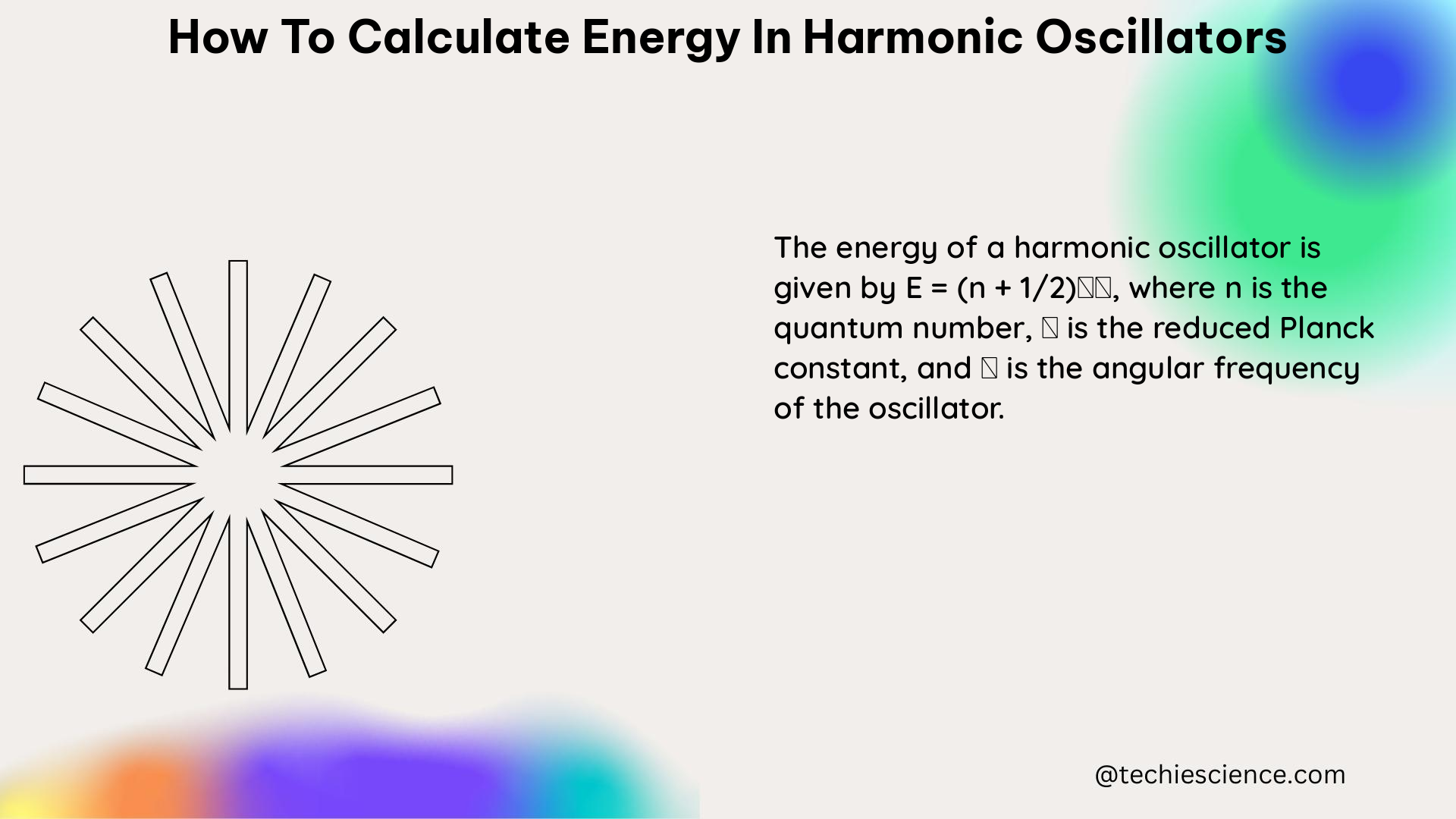Calculating the energy in harmonic oscillators is a fundamental concept in physics, as it helps us understand the behavior of various systems, from simple pendulums to complex molecular vibrations. In this comprehensive guide, we will delve into the details of how to calculate the kinetic energy, potential energy, and total energy of a harmonic oscillator, providing you with a thorough understanding of this topic.
Understanding Harmonic Oscillators
A harmonic oscillator is a system that exhibits simple harmonic motion, where the restoring force is proportional to the displacement from the equilibrium position. This type of motion is commonly observed in various physical systems, such as mass-spring systems, pendulums, and even in the vibrations of atoms within molecules.
Kinetic Energy in Harmonic Oscillators

The kinetic energy (KE) of an object in simple harmonic motion is given by the formula:
KE = (1/2) * m * v^2
Where:
– m is the mass of the object
– v is the velocity of the object
This formula tells us that the kinetic energy of the object is directly proportional to its mass and the square of its velocity. As the object moves through its oscillation, the kinetic energy will vary, reaching a maximum at the equilibrium position and a minimum at the maximum displacement points.
Example Calculation
Consider a mass-spring system with a mass of 2 kg and a spring constant of 50 N/m. If the object has a velocity of 5 m/s at the equilibrium position, what is its kinetic energy?
Given:
– m = 2 kg
– v = 5 m/s
Substituting the values into the formula:
KE = (1/2) * 2 kg * (5 m/s)^2
KE = 62.5 J
Potential Energy in Harmonic Oscillators
The potential energy (PE) of an object in simple harmonic motion is given by the formula:
PE = (1/2) * k * x^2
Where:
– k is the spring constant of the system
– x is the displacement of the object from the equilibrium position
This formula tells us that the potential energy of the object is directly proportional to the square of its displacement from the equilibrium position and the spring constant of the system. The potential energy is maximum at the maximum displacement points and zero at the equilibrium position.
Example Calculation
Continuing the previous example, if the object is displaced by 0.2 m from the equilibrium position, what is its potential energy?
Given:
– k = 50 N/m
– x = 0.2 m
Substituting the values into the formula:
PE = (1/2) * 50 N/m * (0.2 m)^2
PE = 1 J
Total Energy in Harmonic Oscillators
The total energy (E) of a harmonic oscillator is the sum of its kinetic energy and potential energy:
E = KE + PE
E = (1/2) * m * v^2 + (1/2) * k * x^2
This formula tells us that the total energy of the harmonic oscillator is constant, assuming no energy is lost due to friction or other dissipative forces. The energy oscillates between kinetic and potential energy as the object moves through its oscillation.
Example Calculation
Continuing the previous examples, what is the total energy of the mass-spring system?
Given:
– m = 2 kg
– k = 50 N/m
– v = 5 m/s
– x = 0.2 m
Substituting the values into the formula:
KE = (1/2) * 2 kg * (5 m/s)^2 = 62.5 J
PE = (1/2) * 50 N/m * (0.2 m)^2 = 1 J
E = KE + PE = 62.5 J + 1 J = 63.5 J
Damped Harmonic Oscillators
In the case of a damped harmonic oscillator, the energy will decay over time due to the energy loss caused by dissipation. The mechanical energy stored in the potential and kinetic energies is then given by:
E = (1/2) * k * x(t)^2 + (1/2) * m * v(t)^2
Where:
– x(t) and v(t) are the position and velocity of the oscillator at time t
In this case, the total energy of the system will decrease over time as the oscillations are damped.
Conclusion
Calculating the energy in harmonic oscillators is a crucial skill for physics students and researchers. By understanding the formulas for kinetic energy, potential energy, and total energy, you can analyze the behavior of various oscillating systems and gain insights into their underlying physics. This guide has provided you with a comprehensive understanding of how to calculate energy in harmonic oscillators, including examples and specific details to help you master this topic.
References:
- Energy In Simple Harmonic Motion – BYJU’S. https://byjus.com/physics/energy-in-simple-harmonic-motion/
- The Harmonic Oscillator and Infrared Spectra. https://chem.libretexts.org/Bookshelves/Physical_and_Theoretical_Chemistry_Textbook_Maps/Physical_Chemistry_(LibreTexts)/05:_The_Harmonic_Oscillator_and_the_Rigid_Rotor/5.05:_The_Harmonic_Oscillator_and_Infrared_Spectra
- Energy in Simple Harmonic Motion – Physics LibreTexts. https://phys.libretexts.org/Bookshelves/University_Physics/University_Physics_%28OpenStax%29/Book:_University_Physics_I_-_Mechanics_Sound_Oscillations_and_Waves_%28OpenStax%29/15:_Oscillations/15.03:_Energy_in_Simple_Harmonic_Motion

The lambdageeks.com Core SME Team is a group of experienced subject matter experts from diverse scientific and technical fields including Physics, Chemistry, Technology,Electronics & Electrical Engineering, Automotive, Mechanical Engineering. Our team collaborates to create high-quality, well-researched articles on a wide range of science and technology topics for the lambdageeks.com website.
All Our Senior SME are having more than 7 Years of experience in the respective fields . They are either Working Industry Professionals or assocaited With different Universities. Refer Our Authors Page to get to know About our Core SMEs.